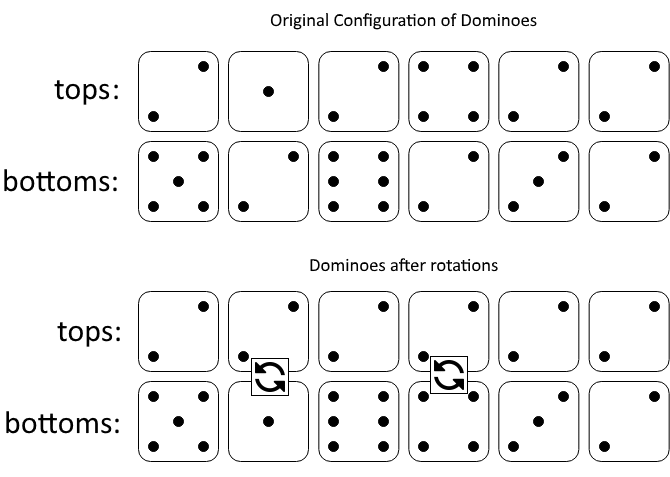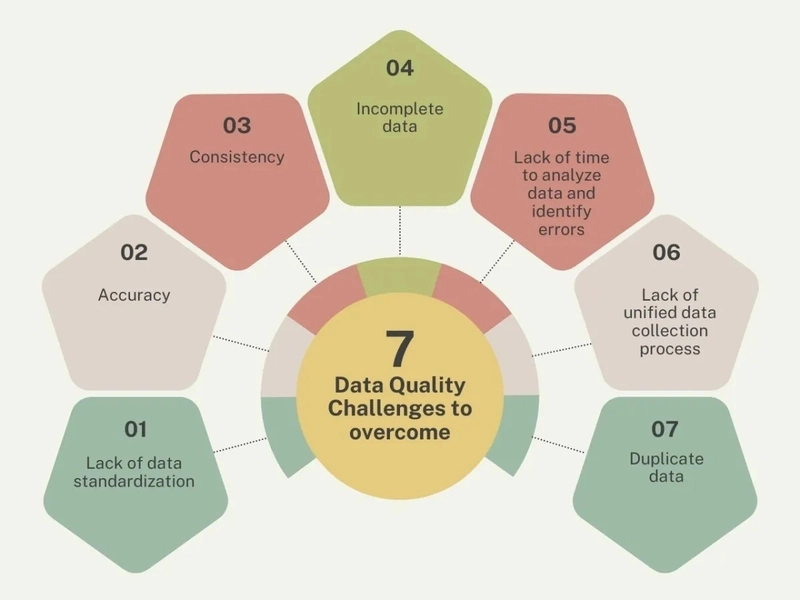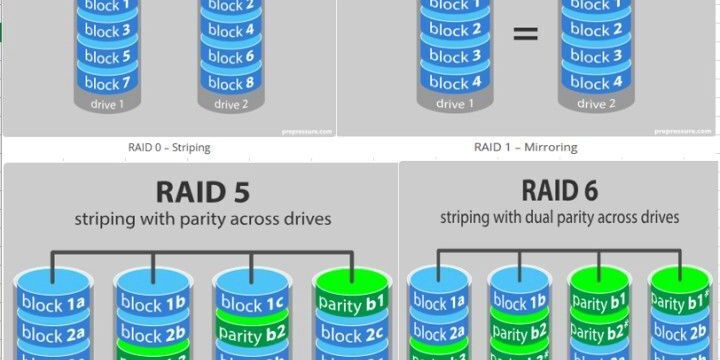1007. Minimum Domino Rotations For Equal Row
1007. Minimum Domino Rotations For Equal Row Difficulty: Medium Topics: Array, Greedy In a row of dominoes, tops[i] and bottoms[i] represent the top and bottom halves of the ith domino. (A domino is a tile with two numbers from 1 to 6 - one on each half of the tile.) We may rotate the ith domino, so that tops[i] and bottoms[i] swap values. Return the minimum number of rotations so that all the values in tops are the same, or all the values in bottoms are the same. If it cannot be done, return -1. Example 1: Input: tops = [2,1,2,4,2,2], bottoms = [5,2,6,2,3,2] Output: 2 Explanation: The first figure represents the dominoes as given by tops and bottoms: before we do any rotations. If we rotate the second and fourth dominoes, we can make every value in the top row equal to 2, as indicated by the second figure. Example 2: Input: tops = [3,5,1,2,3], bottoms = [3,6,3,3,4] Output: -1 Explanation: In this case, it is not possible to rotate the dominoes to make one row of values equal. Constraints: 2

1007. Minimum Domino Rotations For Equal Row
Difficulty: Medium
Topics: Array, Greedy
In a row of dominoes, tops[i] and bottoms[i] represent the top and bottom halves of the ith domino. (A domino is a tile with two numbers from 1 to 6 - one on each half of the tile.)
We may rotate the ith domino, so that tops[i] and bottoms[i] swap values.
Return the minimum number of rotations so that all the values in tops are the same, or all the values in bottoms are the same.
If it cannot be done, return -1.
Example 1:
- Input: tops = [2,1,2,4,2,2], bottoms = [5,2,6,2,3,2]
- Output: 2
-
Explanation: The first figure represents the dominoes as given by tops and bottoms: before we do any rotations.
- If we rotate the second and fourth dominoes, we can make every value in the top row equal to 2, as indicated by the second figure.
Example 2:
- Input: tops = [3,5,1,2,3], bottoms = [3,6,3,3,4]
- Output: -1
- Explanation: In this case, it is not possible to rotate the dominoes to make one row of values equal.
Constraints:
2 <= tops.length <= 2 * 104bottoms.length == tops.length1 <= tops[i], bottoms[i] <= 6
Solution:
We need to determine the minimum number of rotations required to make all values in either the top row or the bottom row of a set of dominoes the same. If it is not possible, we should return -1.
Approach
- Identify Candidates: The target value (which all dominoes must be rotated to) must be present in either the top or bottom of the first domino. This is because if the target value is not in the first domino, it is impossible to make all values in either row match that target.
- Check Validity: For each candidate value from the first domino, check if every domino can contribute this value to either the top or bottom row. If any domino cannot contribute this value, the candidate is invalid.
- Calculate Rotations: For each valid candidate, calculate the number of rotations needed to make all top values the same and the number of rotations needed to make all bottom values the same. The minimum of these two values is the result for that candidate.
- Determine Result: The result is the minimum value among all valid candidates. If no valid candidates exist, return -1.
Let's implement this solution in PHP: 1007. Minimum Domino Rotations For Equal Row
/**
* @param Integer[] $tops
* @param Integer[] $bottoms
* @return Integer
*/
function minDominoRotations($tops, $bottoms) {
...
...
...
/**
* go to ./solution.php
*/
}
// Example 1:
$tops1 = [2,1,2,4,2,2];
$bottoms1 = [5,2,6,2,3,2];
echo minDominoRotations($tops1, $bottoms1) . "\n"; // Output: 2
// Example 2:
$tops2 = [3,5,1,2,3];
$bottoms2 = [3,6,3,3,4];
echo minDominoRotations($tops2, $bottoms2) . "\n"; // Output: -1
?>
Explanation:
- Identify Candidates: The candidates are derived from the first domino's top and bottom values.
- Check Validity: For each candidate, iterate through all dominoes to check if the candidate value is present in either the top or bottom of each domino.
- Calculate Rotations: For each valid candidate, count the number of rotations needed to align all tops or all bottoms with the candidate value. The count is determined by how many dominoes need to be flipped to achieve the target value in the desired row.
- Determine Result: The minimum rotations across all valid candidates is the solution. If no valid candidates are found, return -1.
This approach efficiently narrows down the possible target values and checks each one in linear time, resulting in an overall time complexity of O(n), where n is the number of dominoes.
Contact Links
If you found this series helpful, please consider giving the repository a star on GitHub or sharing the post on your favorite social networks





































































































































































![[The AI Show Episode 145]: OpenAI Releases o3 and o4-mini, AI Is Causing “Quiet Layoffs,” Executive Order on Youth AI Education & GPT-4o’s Controversial Update](https://www.marketingaiinstitute.com/hubfs/ep%20145%20cover.png)




























































































































![[DEALS] Microsoft 365: 1-Year Subscription (Family/Up to 6 Users) (23% off) & Other Deals Up To 98% Off – Offers End Soon!](https://www.javacodegeeks.com/wp-content/uploads/2012/12/jcg-logo.jpg)




![From Art School Drop-out to Microsoft Engineer with Shashi Lo [Podcast #170]](https://cdn.hashnode.com/res/hashnode/image/upload/v1746203291209/439bf16b-c820-4fe8-b69e-94d80533b2df.png?#)




















![Re-designing a Git/development workflow with best practices [closed]](https://i.postimg.cc/tRvBYcrt/branching-example.jpg)




















































































(1).jpg?#)






























_Inge_Johnsson-Alamy.jpg?width=1280&auto=webp&quality=80&disable=upscale#)
































































































![What Google Messages features are rolling out [May 2025]](https://i0.wp.com/9to5google.com/wp-content/uploads/sites/4/2023/12/google-messages-name-cover.png?resize=1200%2C628&quality=82&strip=all&ssl=1)














![New Apple iPad mini 7 On Sale for $399! [Lowest Price Ever]](https://www.iclarified.com/images/news/96096/96096/96096-640.jpg)
![Apple to Split iPhone Launches Across Fall and Spring in Major Shakeup [Report]](https://www.iclarified.com/images/news/97211/97211/97211-640.jpg)
![Apple to Move Camera to Top Left, Hide Face ID Under Display in iPhone 18 Pro Redesign [Report]](https://www.iclarified.com/images/news/97212/97212/97212-640.jpg)
![Apple Developing Battery Case for iPhone 17 Air Amid Battery Life Concerns [Report]](https://www.iclarified.com/images/news/97208/97208/97208-640.jpg)







































































































